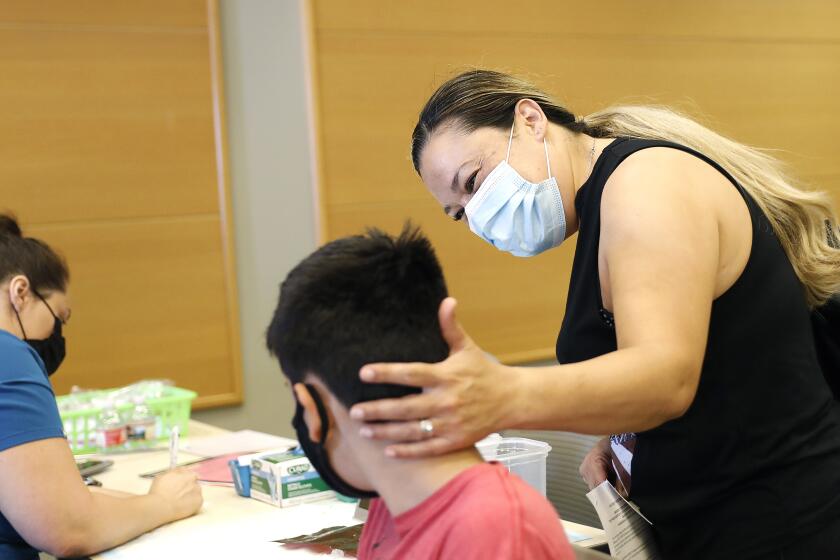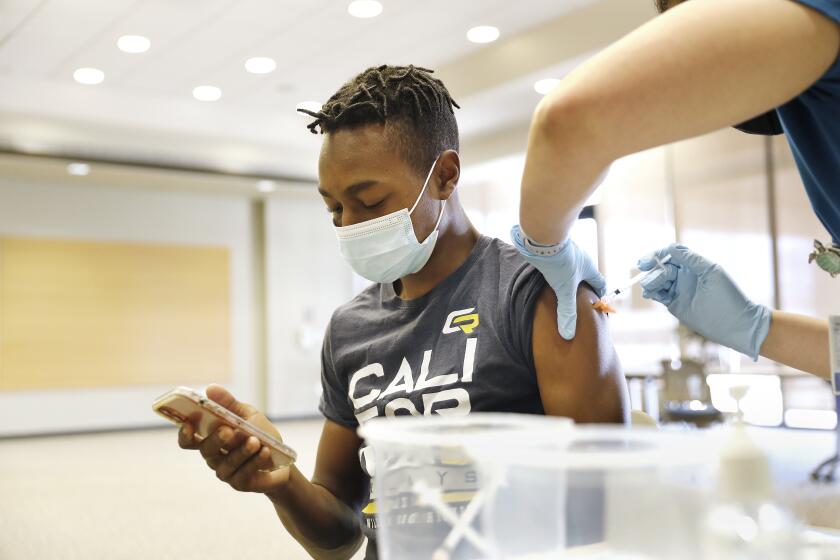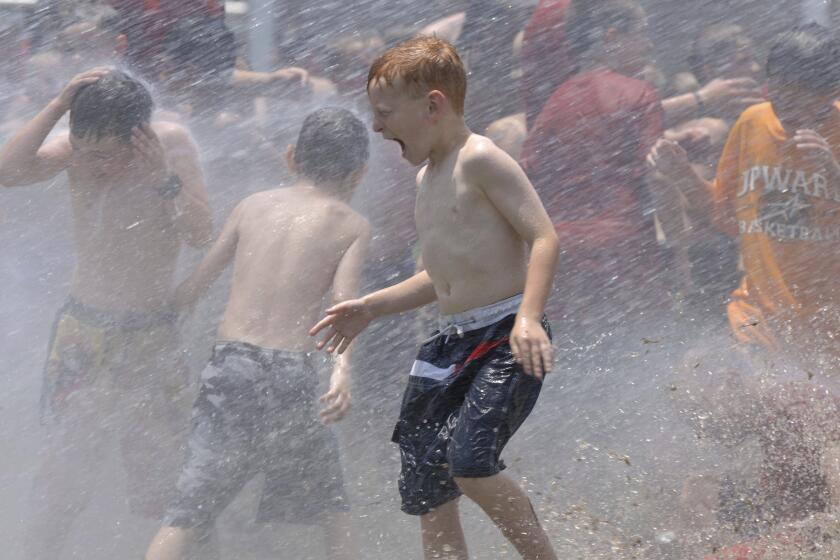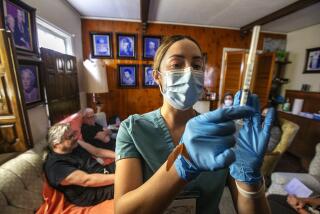Tougher tactics targeting the unvaccinated needed to stop new COVID-19 spike, experts say
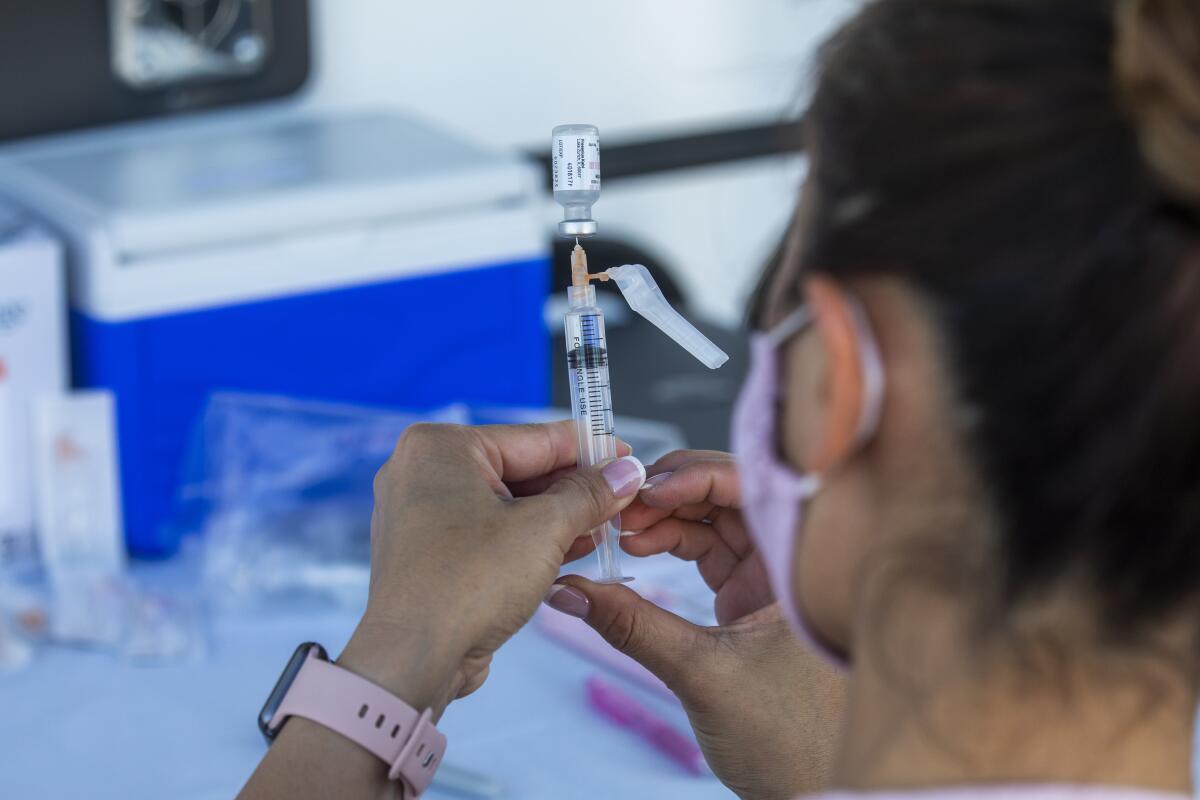
- Share via
With coronavirus cases rising among the unvaccinated and efforts to get them shots lagging, there is growing belief in some public health circles that more aggressive tactics are needed to get more of the population inoculated.
California has already tried prizes and game show-style events to encourage people to get vaccinated. But 41% of Californians of all ages have yet to be inoculated. And two troubling and related trends are bringing calls for fresh thinking.
The coronavirus is spreading in California — mostly among unvaccinated people. While cases and hospitalizations are still more than 93% lower than they were at the peak, new daily coronavirus cases have nearly tripled over the last month, from about 900 a day to more than 2,600 a day; hospitalizations have risen by nearly 75%, from 915 to 1,594.
Meanwhile, the pace of vaccinations continues to tail off. Only about 58,000 vaccine doses a day are being administered statewide, according to figures compiled by The Times. Though that average could rise as more data are reported, it won’t come close to the peak of 400,000 a day.
The solution won’t be easy, but officials and experts are pretty confident they know what will work.
First, sending trusted people in communities to advocate for vaccinations at events and doing door-to-door outreach can do wonders in convincing people to get vaccinated, said UC San Francisco epidemiologist Dr. Kirsten Bibbins-Domingo. Getting vaccines into the offices of primary care physicians, where doctors can answer patients’ questions directly, can help too.
Another strategy would involve new requirements to get vaccinated, such as at workplaces, Bibbins-Domingo said. Short of that, she said, employers could require unvaccinated workers to get tested daily — an approach that has been used elsewhere around the world.
“When being vaccinated becomes the more convenient of the two options, that will drive people to be vaccinated,” Bibbins-Domingo said. “You have to make it slightly less convenient to be unvaccinated at this point.
“If you choose to get tested every day, because you don’t believe in vaccination, that might be fine. But I think for some, being tested every day or being tested at some very regular interval might be that the thing that says: ‘Well, yeah, when I look at the risk and benefits, the vaccine is looking a little bit better.’”
Fully vaccinated people do have very good protection against coronavirus infection and illness. Between Dec. 7 and June 7, unvaccinated people in L.A. County comprised 99.6% of its coronavirus cases, 98.7% of COVID-19 hospitalizations and 99.8% of deaths.
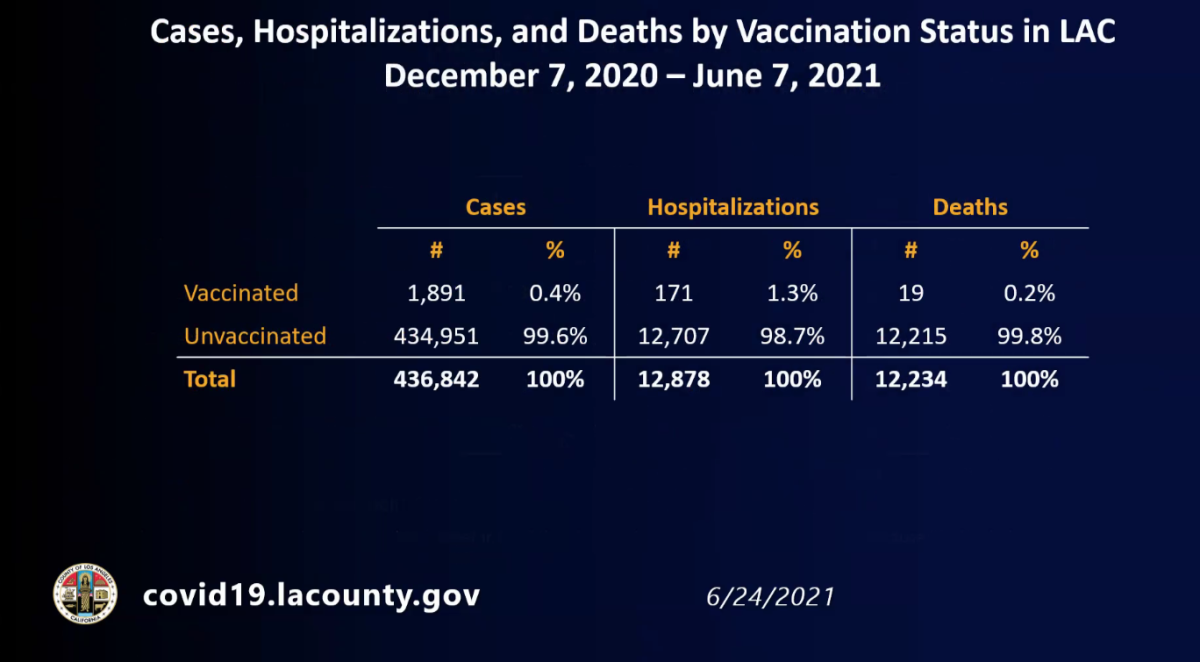
Nonetheless, outbreaks can still be disruptive — and a vaccinated person’s chance of getting infected, while quite small, is worse if they’re around unvaccinated and infected people. At the state Capitol, 10 people have recently tested positive for the coronavirus, including some who were fully vaccinated.
Some health experts have suggested that even vaccinated people wear masks voluntarily in indoor public spaces when weekly case rates are high, which would reduce the risk of a “breakthrough” coronavirus infection.
San Francisco has been a leader in imposing vaccination requirements for certain workers.
Already, San Francisco has ordered all workers in “high-risk settings,” such as hospitals, nursing homes and residential facilities for the elderly, homeless and jails, to be fully vaccinated by Sept. 15. An exemption will be available for workers with valid religious and medical reasons, and they will be required to get tested for the virus weekly.
San Francisco has also ordered all 35,000 of its city workers — including police, firefighters, custodians and clerks — to get vaccinated or risk losing their jobs, unless they have a religious or medical exemption, once a vaccine has been formally approved by the U.S. Food and Drug Administration. Currently, all three available vaccines are being distributed under an emergency use authorization.
The University of California and California State University systems have also announced they will eventually require COVID-19 vaccinations for all students, faculty and staff on campus properties. Dozens of colleges nationwide have said they’ll require vaccination for enrollment in the fall, including Yale, Princeton and Columbia.
Unvaccinated people, perhaps hoping they might outlast the pandemic without getting a shot or getting sick, may be playing an increasingly risky game of chance.
Even if mandates ultimately become more commonplace, on-the-ground outreach is still essential, experts say. And there is good reason to believe more of it will help.
San Francisco, for instance, has one of the highest vaccination rates in California — 75% of residents of all ages are at least partly vaccinated, and 69% are fully vaccinated. While the per capita case rate has increased, it’s still half of L.A. County’s. And while hospitalizations are up in L.A. County, they remain generally stable in San Francisco.
San Francisco’s outreach to the hard-hit Latino community in particular has been a model, with 72% of Latino residents having received at least one dose — a rate even better than white residents, 65% of whom are at least partially vaccinated. In much of the U.S., the vaccination rate for Latinos lags behind white residents.
There have been teams that go out to places like San Francisco’s Tenderloin District, where they interact with people on the streets, in stores and churches to promote vaccinations and administer the shots.
And that kind of interaction can make the difference: Some people can work long hours, and having vaccination advocates make their pitch and answer questions causes someone to finally decide to take the shot, Bibbins-Domingo said.
It’s also important that the people delivering the messages and shots are well trusted in the community.
“It is the linking to the conversation to the actual getting of the shot — and getting the shot from somebody you know and trust — that are the one-two punch to get the job done. And it has been working,” Bibbins-Domingo said.
“It’s just a slow strategy,” she added. But “there are no shortcuts. We have to double down on doing this again — especially for people for whom there are some barriers, whether it is just having the conversation or mistrust.”
The tally marks the fourth consecutive day that new cases totaled more than 1,000, health officials said.
Convincing younger adults by using some combination of the following messages can work: Infected people who were unvaccinated have a greater risk of long-term illness, and unvaccinated people are at greater risk of transmitting the virus to friends and family, including people who have compromised immune systems and might be more likely to get sick.
For many, the personal touch may also be vital — especially when it comes to combating misinformation surrounding the shots. As Dr. Christina Ghaly, L.A. County’s health services director, noted Tuesday: “Relationships really matter.”
“One-on-one conversations — it’s very labor intensive, not always very fast, it takes time. But that’s been the best thing that has really helped,” she said.
In Santa Clara County, which also has a high vaccination rate and stable hospitalizations, officials identified census tracts with the lowest vaccination rates and focused on them to launch vaccination clinics. They’ve also focused on essential workers in industries like child care, education and agriculture, and have worked with unions and employers to reach more people.
In the Central Valley, UC Merced Community and Labor Center Executive Director Ana Padilla said there still needs to be better access to the vaccine — and good information about it — to people like agricultural workers, who are now working the busiest time of the year. She suggested that there be a greater effort to link trusted community-based groups to administer vaccines near work sites, which will be better equipped to answer questions from workers.
“If you work 8 to 8 — every single day of the week — so that you have enough money to get through those hard winter months, you don’t have the options [to seek vaccinations] that other folks might believe that you have,” Padilla said.
L.A. County — where 60% of residents of all ages have at least one dose, and 52% are fully vaccinated — is taking a similar approach in focusing vaccination clinics in hard-hit areas. But L.A. County has a far more vast challenge — it’s the nation’s most populous county, and blanketing the county with intense outreach efforts might be more difficult here.
A string of COVID-19 outbreaks tied to U.S. summer camps in recent weeks has some people fearing it could be a preview of the upcoming school year.
Times staff writer John Myers and intern Melissa Hernandez contributed to this report.
More to Read
Sign up for Essential California
The most important California stories and recommendations in your inbox every morning.
You may occasionally receive promotional content from the Los Angeles Times.
